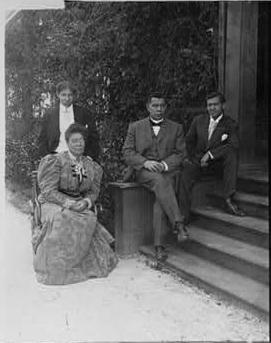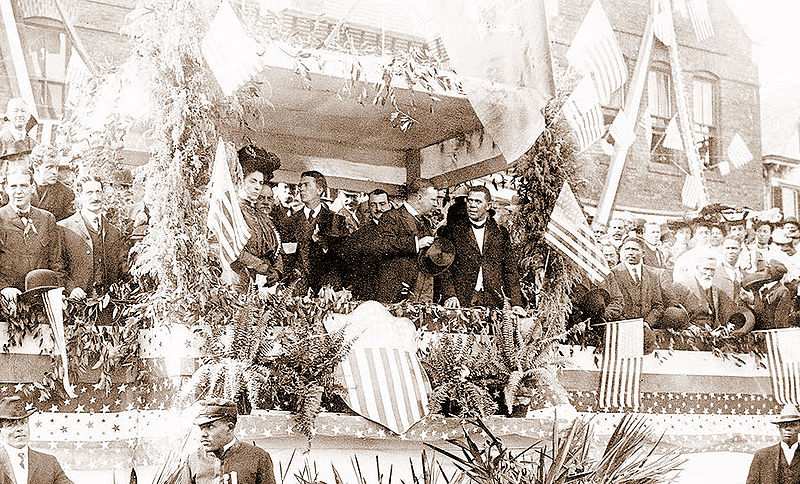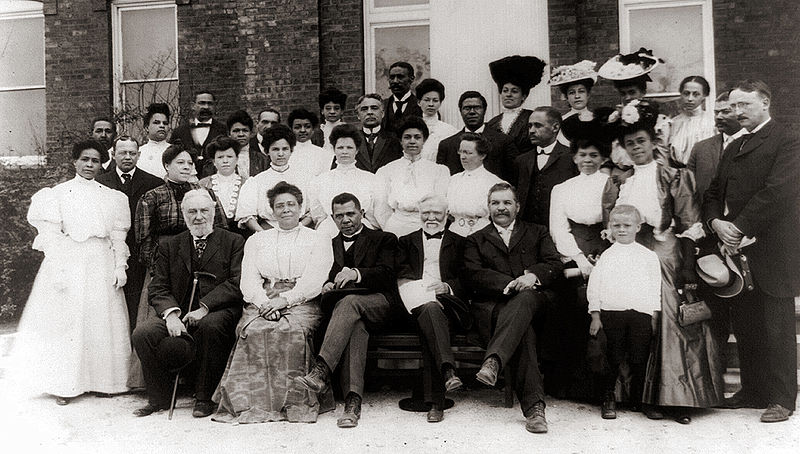<Back to Index>
- Physicist Sergey Alexeyevich Chaplygin, 1869
- Writer Algernon Charles Swinburne, 1837
- Civil Rights Leader and Educator Booker Taliaferro Washington, 1856
PAGE SPONSOR
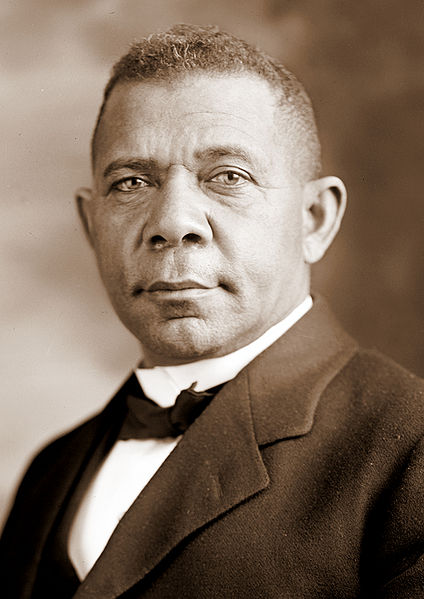
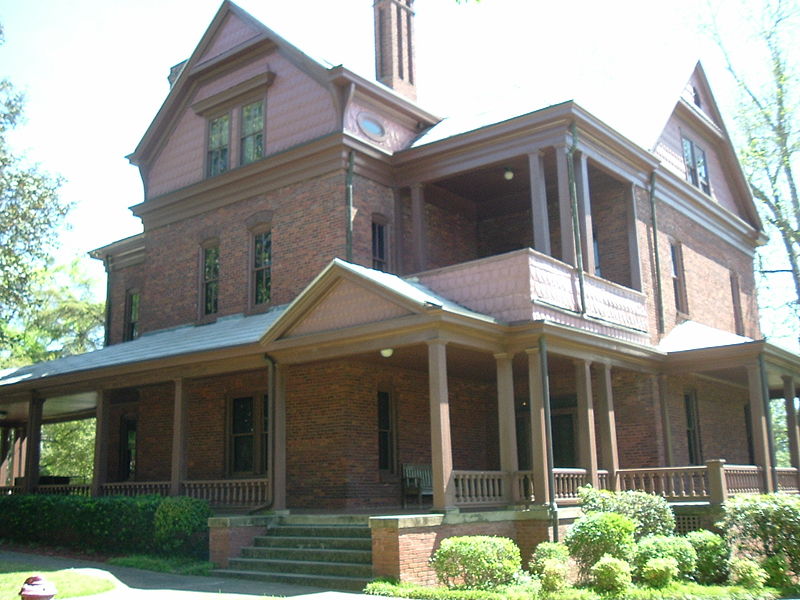
Booker Taliaferro Washington (April 5, 1856 – November 14, 1915) was an American educator, author, orator, and political leader. He was the dominant figure in the African American community in the United States from 1890 to 1915. Representative of the last generation of black leaders born in slavery, he spoke on behalf of the large majority of blacks who lived in the South but had lost their right to vote. While his opponents called his powerful network of supporters the "Tuskegee Machine," Washington maintained his power because of the sponsorship of powerful whites, widespread support within the black business, educational and religious communities nationwide, his ability to raise large amounts of money from philanthropists, and his accommodation to the political realities of the age of Jim Crow segregation.
Washington was born into slavery to a slave mother and white father, who was a nearby planter, in a rural area in southwestern Virginia. After emancipation, he worked in West Virginia in a variety of manual labor jobs before making his way to Hampton Roads seeking an education. He worked his way through Hampton Normal and Agricultural Institute (now Hampton University) and attended college at Wayland Seminary (now Virginia Union University). After returning to Hampton as a teacher, in 1881 he was named as the first leader of the new Tuskegee Institute in Alabama.
Washington attained national prominence for his Atlanta Address of 1895, which attracted the attention of politicians and the public, making him a popular spokesperson for African - American citizens. He built a nationwide network of supporters in many black communities, with black ministers, educators and businessmen composing his core supporters. Washington played a dominant role in black politics, winning wide support in the black community and among more liberal whites (especially rich Northern whites). He gained access to top national leaders in politics, philanthropy and education. Washington's efforts included cooperating with white people and enlisting the support of wealthy philanthropists, helping to raise funds to establish and operate thousands of small community schools and institutions of higher education for the betterment of blacks throughout the South. This work continued for many years after his death.
Northern critics called Washington's followers the "Tuskegee Machine". After 1909, Washington was criticized by the leaders of the new NAACP, especially W.E.B. Du Bois, who demanded a stronger tone of protest for advancement of civil rights needs. Washington replied that confrontation would lead to disaster for the outnumbered blacks, and that cooperation with supportive whites was the only way to overcome pervasive racism in the long run. At the same time, he secretly funded litigation for civil rights cases, such as challenges to southern constitutions and laws that disenfranchised blacks.
In addition to his contributions in education, Washington wrote 14 books; his autobiography, Up From Slavery,
first published in 1901, is still widely read today. During a difficult
period of transition, he did much to improve the working relationship
between the races. His work greatly helped blacks to achieve higher
education, financial power and understanding of the U.S. legal system.
This led to a foundation of the skill set needed to support the Civil
Rights Movement of the 1960s and further adoption of important federal
civil rights laws. Washington
was born into slavery to Jane, an enslaved African - American woman on
the Burroughs Plantation in southwest Virginia. He knew little about
his white father. His family gained freedom in 1865 as the Civil War
ended. As a boy he claimed the surname Washington at school.
He worked in salt furnaces and coal mines in West Virginia for several years then made his way east to Hampton Institute,
a school established to educate freedmen, where he worked to pay for
his studies. He attended Wayland Seminary in Washington D.C. in 1878
and left after 6 months. In 1881, Hampton president Samuel C. Armstrong recommended Washington to become the first leader of Tuskegee Institute, the new normal school (teachers' college) in Alabama. He headed it for the rest of his life. Washington was a dominant figure of the African - American community from 1890 to his death in 1915, especially after his Atlanta Address of 1895.
To many he was seen as a popular spokesman for African - American
citizens. Representing the last generation of black leaders born into
slavery, Washington was generally perceived as a supporter of education
for freedmen in the post - Reconstruction, Jim Crow - era South.
Throughout the final twenty years of his life, he maintained his
standing through a nationwide network of supporters including black
educators, ministers, editors, and businessmen, especially those who
supported his views on social and educational issues for blacks. He
gained access to top national leaders in politics, philanthropy and
education, raised large sums, was consulted on race issues and was
awarded honorary degrees from leading American universities. Late in his career, Washington was criticized by leaders of the NAACP, a civil rights organization formed in 1909. W.E.B. Du Bois advocated activism to achieve civil rights. He labeled Washington "the Great
Accommodator". Washington's response was that confrontation could lead
to disaster for the outnumbered blacks. He believed that cooperation
with supportive whites was the only way in the long run to overcome
racism. Washington contributed secretly and substantially to legal challenges against segregation and disfranchisement of blacks. In his public role, he believed he could achieve more by skillful accommodation to the social realities of the age of segregation. Washington's work on education issues helped him enlist both the moral and substantial financial support of many major white philanthropists. He became friends with such self made men as Standard Oil magnate Henry Huttleston Rogers; Sears, Roebuck and Company President Julius Rosenwald; and George Eastman,
inventor and founder of Kodak. These individuals and many other wealthy
men and women funded his causes, including Hampton and Tuskegee
institutes. The
schools Washington supported were founded to produce teachers. However,
graduates had often gone back to their largely impoverished rural
southern communities only to find precious few schools and educational
resources. To address those needs, Washington enlisted his
philanthropic network of matching funds programs to stimulate
construction of numerous rural public schools for black children in the
South. Together, these efforts eventually established and operated over
5,000 schools and supporting resources for the betterment of blacks
throughout the South in
the late 19th and early 20th centuries. The local schools were a source
of communal pride and were priceless to African - American families
when
poverty and segregation limited severely the life chances of the
pupils. A major part of Washington's legacy, the number of model rural
schools increased with matching funds from the Rosenwald Fund into the 1930s. He also helped with the Progressive Era by forming the National Negro Business League. His autobiography, Up From Slavery, first published in 1901, is still widely read today. The
organizers of the new all black state school called Tuskegee Normal and
Industrial Institute in Alabama found the energetic leader they sought
in 25 year old Washington. He believed that with self help, people
could go from poverty to success. The new school opened on July 4,
1881, initially using space in a local church. The next year,
Washington purchased a former plantation, which became the permanent
site of the campus. Under his direction, his students literally built
their own school: constructing classrooms, barns and outbuildings; and
growing their own crops and raising livestock; both for learning and to
provide for most of the basic necessities. Both
men and women had to learn trades as well as academics. Washington
helped raise funds to establish and operate hundreds of small community
schools and institutions of higher educations for blacks. The
Tuskegee faculty used all the activities to teach the students basic
skills to take back to their mostly rural black communities throughout
the South. The main goal was not to produce farmers and tradesmen, but
teachers of farming and trades who taught in the new schools and
colleges for blacks across the South. The school expanded over the
decades, adding programs and departments, to become the present day
Tuskegee University. Washington
expressed his aspirations for his race in his direction of the school.
He believed that by providing needed skills to society, African
Americans would play their part, leading to acceptance by white
Americans. He believed that blacks would eventually gain full
participation in society by acting as responsible, reliable American
citizens. Shortly after the Spanish - American War, President William McKinley and
most of his cabinet visited Washington. He led the school until his
death in 1915. By then Tuskegee's endowment had grown to over $1.5
million, compared to its initial $2,000 annual appropriation.
Washington was married three times. In his autobiography
Up From Slavery, he gave all three of his wives credit for their contributions at Tuskegee. His first wife Fannie N. Smith was from Malden, West Virginia, the same Kanawha River Valley town
where Washington had lived from age nine to sixteen. He maintained ties
there all his life. Washington and Smith were married in the summer of
1882. They had one child, Portia M. Washington. Fannie died in May 1884. Washington next wed Olivia A. Davidson in 1885. Born in Ohio, she had studied at Hampton Institute and the Massachusetts State Normal School at Framingham.
She taught in Mississippi and Tennessee before going to Tuskegee to
work. Washington met Davidson as a teacher at Tuskegee, where she was
promoted to assistant principal there. They had two sons, Booker T.
Washington Jr. and Ernest Davidson Washington, before she died in 1889. In 1893 Washington married Margaret James Murray. She was from Mississippi and had graduated from Fisk University, a historically black college. They had no children together, but she helped rear Washington's children. Murray outlived Washington and died in 1925. Washington’s 1895 Atlanta Exhibition address was viewed as a “revolutionary moment” by both African - Americans and whites across the country. Then W.E.B. Du Bois supported
him, but they grew apart as Du Bois sought more action to remedy
disenfranchisement and lower education. After their falling out, Du
Bois and his supporters referred to Washington's speech as the "Atlanta
Compromise" to express their criticism that Washington was too
accommodating to white interests. Washington advocated a “go slow” approach. The
effect was that many youths in the South had to accept sacrifices of
potential political power, civil rights and higher education. His
belief was that African - Americans should “concentrate all their
energies on industrial education, and accumulation of wealth, and the
conciliation of the South.” Washington
valued the "industrial" education, as it provided critical skills for
the jobs then available to the majority of African - Americans at the
time, as most lived in the South, which was overwhelmingly rural and
agricultural. He thought these skills that would lay the foundation for
the creation of stability that the African - American community required
in order to move forward. He believed that in the long term “blacks
would eventually gain full participation in society by showing
themselves to be responsible, reliable American citizens.” His approach
advocated for an initial step toward equal rights, rather than full
equality under the law. It would be this step that would provide the
economic power to back up their demands for equality in the future. This
action, over time, would provide the proof to a deeply prejudiced white
America that they were not in fact “’naturally’ stupid and incompetent.” This stance was contrary to what many blacks from the North envisioned. Du Bois wanted blacks to have the same "classical" liberal arts education as whites did, along with voting rights and civic equality. He believed that an elite he called the Talented Tenth would advance to lead the race to a wider variety of occupations. The
source of division between Du Bois and Washington was generated by the
differences in how African Americans were treated in the North versus
the South. Many in the North felt that they were being 'led', and
authoritatively spoken for, by a Southern accommodationist imposed on
them primarily by Southern whites.” Furthermore,
historian Clarence E. Walker said, "Free black people were 'matter out
of place'. Their emancipation was an affront to southern white freedom.
Booker T. Washington did not understand that his program was perceived
as subversive of a natural order in which black people were to remain
forever subordinate or unfree." Both
men sought to define the best means to improve the conditions of the
post - Civil War African - American community through education. Blacks were solidly Republican in
this period. Southern states disfranchised most blacks and many poor
whites from 1890 – 1908 through constitutional amendments and statutes
that created barriers to voter registration, and voting such as poll taxes and
literacy tests. Southern white Democrats regained power in the state
legislatures of the former Confederacy and passed laws establishing
racial segregation and other Jim Crow laws. More blacks continued to
vote in border and Northern states. Washington
worked and socialized with many white politicians and industry leaders.
Much of his expertise was his ability to persuade wealthy whites to
donate money to black causes. He argued that the surest way for blacks
to gain equal social rights was to demonstrate “industry, thrift,
intelligence and property.” This
was the key to improved conditions for African Americans in the United
States. Because they had only recently been emancipated, he believed
they could not expect too much at once. Washington said, "I have
learned that success is to be measured not so much by the position that
one has reached in life as by the obstacles which he has had to
overcome while trying to succeed. Along with Du Bois, he partly organized the "Negro exhibition" at the 1900 Exposition Universelle in Paris, where photos, taken by his friend Frances Benjamin Johnston, of Hampton Institute's black students were displayed. The exhibition expressed African Americans' positive contributions to American society. Washington privately contributed substantial funds for legal challenges to segregation and disfranchisement, such as the case of Giles v. Harris, which went before the United States Supreme Court in 1903.
Washington
associated with the richest and most powerful businessmen and
politicians of the era. He was seen as a spokesperson for African
Americans and became a conduit for funding educational programs. His
contacts included such diverse and well known personages as
Andrew Carnegie, William Howard Taft, John D. Rockefeller, Henry Huttleston Rogers, George Eastman, Julius Rosenwald, Robert Ogden, Collis P. Huntington and William Henry Baldwin Jr.,
who donated large sums of money to agencies such as the Jeanes and
Slater Funds. As a result, countless small schools were established
through his efforts, in programs that continued many years after his
death. Along with rich people, black communities also helped their
communities by donating time, money and labor to schools. Churches such
as the Baptist and Methodist also supported black schools at both the
elementary and secondary levels. A few weeks later Washington went on a previously planned speaking tour along the newly completed Virginian Railway,
a $40 million enterprise which had been built almost entirely from
Rogers' personal fortune. As Washington rode in the late financier's private railroad car, "Dixie",
he stopped and made speeches at many locations, where his companions
later recounted that he had been warmly welcomed by both black and
white citizens at each stop. Washington
revealed that Rogers had been quietly funding operations of 65 small
country schools for African Americans, and had given substantial sums
of money to support Tuskegee and Hampton institutes. He also disclosed
that Rogers had encouraged programs with matching funds requirements so the recipients had a stake in the outcome.
In 1907 Anna T. Jeanes (1822 – 1907)
donated one million dollars to Washington for elementary schools for
black children in the South. Her contributions and those of Henry
Rogers and others funded schools in many poor communities. Julius Rosenwald (1862 – 1932)
was another self made wealthy man with whom Washington found common
ground. By 1908 Rosenwald, son of an immigrant clothier, had become
part owner and president of Sears, Roebuck and Company in
Chicago. Rosenwald was a philanthropist who was deeply concerned about
the poor state of African - American education, especially in the
Southern states, where their schools were underfunded. In
1912 Rosenwald was asked to serve on the Board of Directors of Tuskegee
Institute, a position he held for the remainder of his life. Rosenwald
endowed Tuskegee so that Washington could spend less time fundraising
and more managing the school. Later in 1912 Rosenwald provided funds
for a pilot program to build six new small schools in rural Alabama.
They were designed, constructed and opened in 1913 and 1914 and
overseen by Tuskegee; the model proved successful. Rosenwald established the Rosenwald Fund.
The school building program was one of its largest programs. Using
architectural model plans developed by professors at Tuskegee
Institute, the Rosenwald Fund spent over $4 million to help build 4,977
schools, 217 teachers' homes, and 163 shop buildings in 883 counties in
15 states, from Maryland to Texas. The Rosenwald Fund made matching grants, requiring community support and fundraising. Black communities raised more than $4.7 million to aid the construction. These schools became informally known as Rosenwald Schools. By 1932, the facilities could accommodate one third of all African - American children in Southern U.S. schools. Washington published five books during his lifetime with the aid of ghost - writers Max Bennett Thrasher and Robert E.Park. They were compilations of speeches and essays: The Story of My Life and Work (1900), Up From Slavery (1901), The Story of the Negro: The Rise of the Race from Slavery (2 vol 1909), My Larger Education (1911), The Man Farthest Down (1912). In
an effort to inspire the "commercial, agricultural, educational, and
industrial advancement" of African Americans, Washington founded the National Negro Business League (NNBL) in 1900. When Washington's autobiography, Up From Slavery,
was published in 1901, it became a bestseller and had a major impact on
the African American community, its friends and allies. One of the
results was a dinner invitation in 1901 by Theodore Roosevelt. James K. Vardaman, soon to be Governor of Mississippi, and Benjamin Tillman, US Senator for South Carolina,
indulged in racist personal attacks in response to the invitation.
Vardaman described the White House as "so saturated with the odor of
the nigger that the rats have taken refuge in the stable", and
declared "I am just as much opposed to Booker T. Washington as a voter
as I am to the cocoanut - headed, chocolate - colored typical little coon
who blacks my shoes every morning. Neither is fit to perform the
supreme function of citizenship." Tillman
opined that "The action of President Roosevelt in entertaining that
nigger will necessitate our killing a thousand niggers in the South
before they will learn their place again." Austro - Hungarian Ambassador Ladislaus Hengelmüller von Hengervár, visiting the White House on the same day, claimed to have found a rabbit's foot in Washington's coat pocket when he mistakenly put on the coat; The Washington Post elaborately described it as "the left hind foot of a graveyard rabbit, killed in the dark of the moon". The Detroit Journal quipped
the next day, "The Austrian ambassador may have made off with Booker T.
Washington's coat at the White House, but he'd have a bad time trying
to fill his shoes."
Despite
his travels and widespread work, Washington remained as principal of
Tuskegee. Washington's health was deteriorating rapidly; he collapsed
in New York City and was brought home to Tuskegee, where he died on
November 14, 1915, at the age of 59. He was buried on the campus of
Tuskegee University near the University Chapel.
His death was believed at the time to have been a result of
congestive heart failure,
aggravated by overwork. In March 2006, with the permission of his
descendants, examination of medical records indicated that he died of hypertension, with a blood pressure more than twice normal, confirming what had long been suspected. At
his death Tuskegee's endowment exceeded $1.5 million. His greatest
life's work, the work of education of blacks in the South, was well
underway and expanding. For his contributions to American society, Washington was granted an honorary master's degree from Harvard University in 1896 and an honorary doctorate from Dartmouth College in 1901. Washington, as the guest of President Theodore Roosevelt in
1901, was the first African - American ever invited to the White House.
At the end of the 2008 presidential election, the defeated Republican
candidate, Senator John McCain,
referred to Washington’s visit to the White House a century before as
the seed that blossomed into the first African American becoming the
President of the United States, Barack Obama. The visit was also recalled in the 1927 song by Banjo Blues Musician Gus Cannon, titled "Can You Blame The Coloured Man". In 1934 Robert Russa Moton,
Washington's successor as president of Tuskegee University, arranged an
air tour for two African American aviators, and afterward the plane was
christened the Booker T. Washington. On
April 7, 1940, Washington became the first African American to be
depicted on a United States postage stamp. The first coin to feature an
African American was the Booker T. Washington Memorial Half Dollar that
was minted by the United States from 1946 to 1951. He was also depicted
on a U.S. Half Dollar from 1951 – 1954.
In 1942, the
Liberty Ship Booker T. Washington was named in his honor, the first major oceangoing vessel to be named after an African American. The ship was christened by Marian Anderson. On April 5, 1956, the hundredth anniversary of Washington's birth, the house where he was born in Franklin County, Virginia, was designated as the Booker T. Washington National Monument. A state park in Chattanooga, Tennessee, was named in his honor, as was a bridge spanning the Hampton River adjacent to his alma mater, Hampton University. In 1984 Hampton University dedicated a Booker T. Washington Memorial on campus near the historic Emancipation Oak,
establishing, in the words of the University, "a relationship between
one of America's great educators and social activists, and the symbol of Black achievement in education." Numerous high schools, middle schools and elementary schools across the United States have been named after Booker T. Washington. At
the center of the campus at Tuskegee University, the Booker T.
Washington Monument, called "Lifting the Veil," was dedicated in 1922. The inscription at its base reads:
